
The aging process is a complex issue that includes everything from health care to social assistance. These issues are of major concern to policy makers, doctors, and general public. The issues become more pressing as the population gets older and age-diversity increases.
Aging issues: Older people are often affected by physical and mental illnesses, as they age. There may also be behavioral changes leading to problems such as depression and anxiety. Often, these signs and symptoms are not noticed, but they can have serious impacts on the ability of an individual to remain independent.
In many cases these ageing issues can be effectively treated. In some cases, however, these health issues can become severe and even fatal.
Multiple health issues: People of any age, regardless of the level of physical and cognitive function they possess, can lead healthier lives and enjoy greater independence, if only they had the resources and knowledge to deal with these age-related challenges.

A wide range of research focuses on these health issues. These health issues are the focus of a wide range of research.
This will require an effort to move beyond traditional silos. It will also require a restructuring of incentives and funding for the health sector. It won't happen overnight, however it is essential to prevent a decline in quality of living and independence among a rapidly-growing population.
Why is Aging an Issue Today?
The population of the world is ageing, with the number of people over 60 expected to rise to more than 1.5 billion by mid-century. This trend is a result of declining fertility, an increase in longevity, and a progression of large cohorts to older ages.
This phenomenon is having a profound effect on the economic development of our society, as well as the environment. The need for demographic preparedness has become a global concern. For demographic preparedness, the most achievable goals are improving reproductive health, providing people with the physical and human capital needed to be productive in society, assuring that the labor and capital market functions well, which allows people to reach their full potential, and establishing policies and institutions that limit the environmental burdens that people place.
Nevertheless, this aging phenomenon has been the subject of controversy in many countries, with some groups viewing it as a threat to society while others view it as a source of opportunity and wealth. Even though there are different opinions, a large majority of the population in the world agrees that aging is a serious issue that should be addressed by all policy makers.

The ageing issue is global and has major implications for all sectors, such as health, finance, or labour markets. It has important implications for intergenerational ties and family structures.
In the end, the aging phenomena will have a major and lasting effect on societies. All sectors, policymakers, government officials, and the general public must take action in order to tackle the many challenges related to aging.
FAQ
What is the distinction between public and private health?
Both terms refers to the policies made by legislators or policymakers to change how health services are delivered. It could be local, regional, or national to decide whether a new hospital should be built. The same goes for the decision whether to require employers provide health insurance. This can be done by local, national or regional officials.
What's the difference between a doctor, and a physician?
A doctor refers to a person who is licensed to practise medicine and has completed his/her training. A physician can be described as a medical professional who is skilled in a specific area of medicine.
What is my role within public health?
You can help protect your own health and the health of others by taking part in prevention efforts. By reporting illness and injury to health professionals, you can improve public health.
Statistics
- Over the first twenty-five years of this transformation, government contributions to healthcare expenditures have dropped from 36% to 15%, with the burden of managing this decrease falling largely on patients. (en.wikipedia.org)
- The healthcare sector is one of the largest and most complex in the U.S. economy, accounting for 18% of gross domestic product (GDP) in 2020.1 (investopedia.com)
- Consuming over 10 percent of [3] (en.wikipedia.org)
- Foreign investment in hospitals—up to 70% ownership- has been encouraged as an incentive for privatization. (en.wikipedia.org)
- For instance, Chinese hospital charges tend toward 50% for drugs, another major percentage for equipment, and a small percentage for healthcare professional fees. (en.wikipedia.org)
External Links
How To
What is the Healthcare Industry Value Chain (or Value Chain)?
The entire healthcare industry value-chain includes all activities related to providing healthcare services to patients. This includes the operations of hospitals and clinics as a whole, and the supply chain that connects them to other providers. The final result is a continuum in care that begins with diagnosis, and ends with discharge.
The four key components of the value chain are:
-
Business Processes are the tasks carried out by employees throughout the entire health care delivery process. A doctor might conduct an exam, prescribe medication and send a prescription to a pharmacy. Each step must always be done quickly and accurately.
-
Supply Chains - All the organizations involved in making sure that the right supplies reach the right people at the right time. A typical hospital has dozens of suppliers, including pharmacies, lab testing facilities, imaging centers, and even janitorial staff.
-
Networked organizations - These entities must communicate with each other in order to coordinate. Hospitals are often composed of many departments. Each department will have its own set office and telephone number. To ensure that everyone is up to date, every department will have a central point from which employees can access updates.
-
Information Technology Systems- IT is vital in ensuring smooth business processes. Without it things would quickly fall apart. IT can also be used to integrate new technologies into a system. Doctors, for example, can connect to a secure internet connection to access electronic medical records.